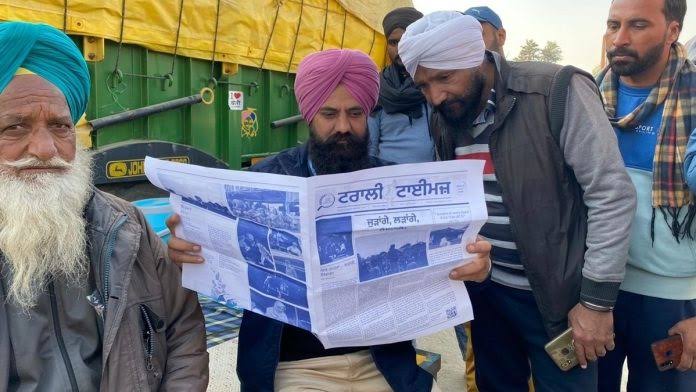Previously, crouching in a trailer, a group of four youths discussed a Facebook post at the Singhu border. An old farmer, crouching next to them, quipped: “Oye mundiyo tusi parhe likhe lagde ho, saanu vi dass do ki ho reha” ( Hey Mundiyo, you seem to be literate, you know what is happening?) Therefore the idea of Trolley Times was born. Farmers’ own newspaper.
Reporters were aplenty; an army of apprentice photographers was ready with the feed, a trailer came to be their editing desk, and shortly came out the first publication of 2,000 copies of four-page bilingual weekly newspaper called Trolley Times.
The first edition of the newspaper turned up on Saturday. The problem had three long-form articles in Gurmukhi, features, photos, diagrams and a Hindi section for protestors from states other than Punjab.
ALSO READ – Cambodia’s Pioneering Post-khmer Rouge Era Phnom Penh Post Newspaper Will Stop Print Publication
The FrontPage tagline said, “Judaange, ladaange, jeetange! (United, we will fight and win).” Another cited Bhagat Singh: “Inquilaab di talwar vichaaran di saan tey tez hondi ae (The sword of revolution is sharpened at the whetstone of ideas).”
It also brought out the story of a woman farmer, Gurmail Kaur, who died during the protest; some works of art and the lead article gave the connotation of unity, struggle and victory. The paper was simultaneously inaugurated digitally on all social media platforms like Facebook, Twitter, etc.

“Looking at the reaction, we are going to print 10,000 copies of the next issue,” says Ajaypal Natt from Mansa, a physiotherapy educator. He along with Surmeet Mavi, Gurdeep Singh and Narinder Bhinder developed the idea. The name, Natt says, was fluttered by one of us just out of leisure. “But we instantly picked that,” he explains.
And further added The style of the paper, will be conversational. “We want it to read like the discussions taking place in village sath (common place),” he explains, “we have a platform now to counter all kind of trash being dished out by some sections of media.”
Weathered of a late-night conversation less than a week ago among some artists on a tractor-trolley at Singhu border, its objective is to assure that the message from the dais, the latest improvements in talks with the government and other details about the protest are easily available for the protesting farmers.
With an approximate three lakh people now gathered on the Delhi borders, it has become crucial for the protestor to all be on the same page about the protest and the government’s acknowledgement.
The first publication of Trolley Times was issued in Gurgaon. The printing expense for 2,000 copies came to Rs 11,000. Of these, 1,200 are inferred for distribution at Singhu border and 800 at Tikri.
“You will find a copy of the newspaper in every second trolley and we will increase the number of copies printed,” told Kattar Singh, who has been at Singhu since the initial day of the protest on November 27.
Rahul Singh of Chandigarh amplified, “We have ensured the newspaper is not just in Gurmukhi but also in Hindi so more people understand the content. We were quite quick in deciding the headlines, editing the content and making the masthead.”
While this publication could not get any information from Ghazipur, where at least 500 people have dwelled in protest, the farmers are wishing to get a story from that border point in the next publication.
Also, read:
SC upheld farmers right to protest, asks the Centre to put the new farm laws on hold
With Thousands of people revolting with farmers, this is why Prime Minister Modi should care